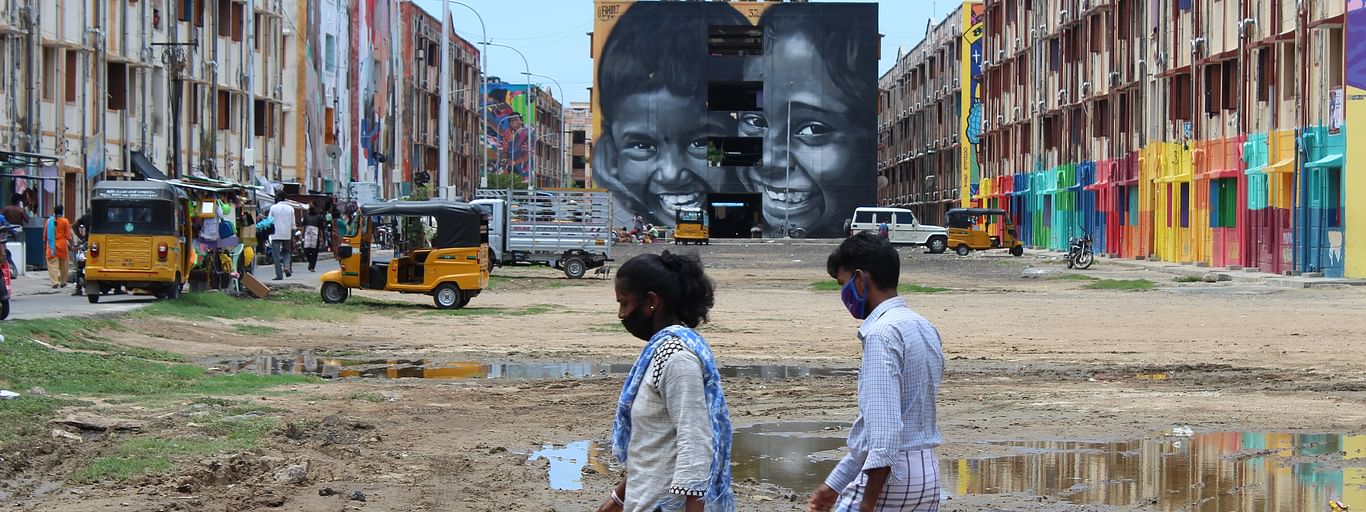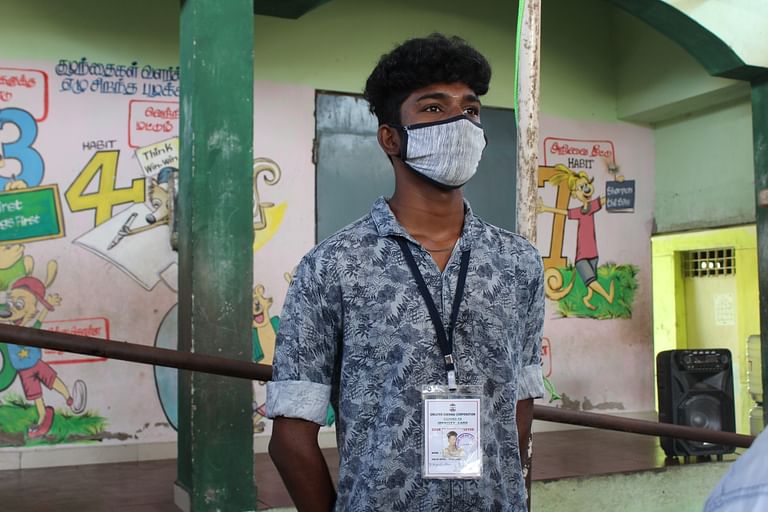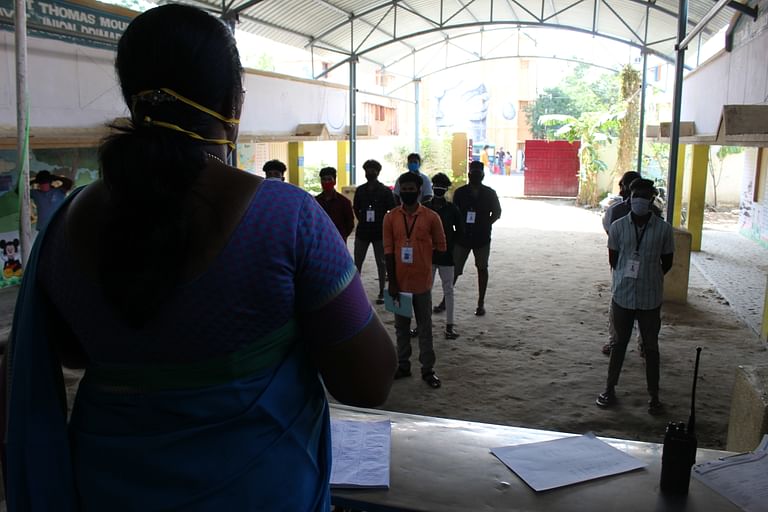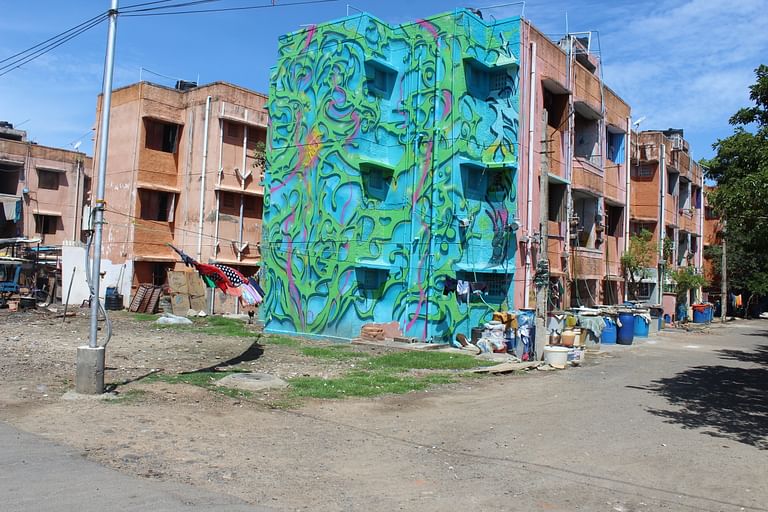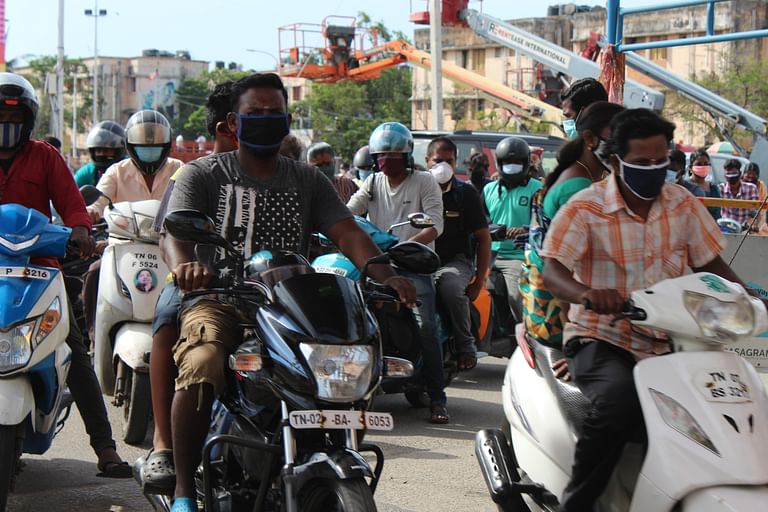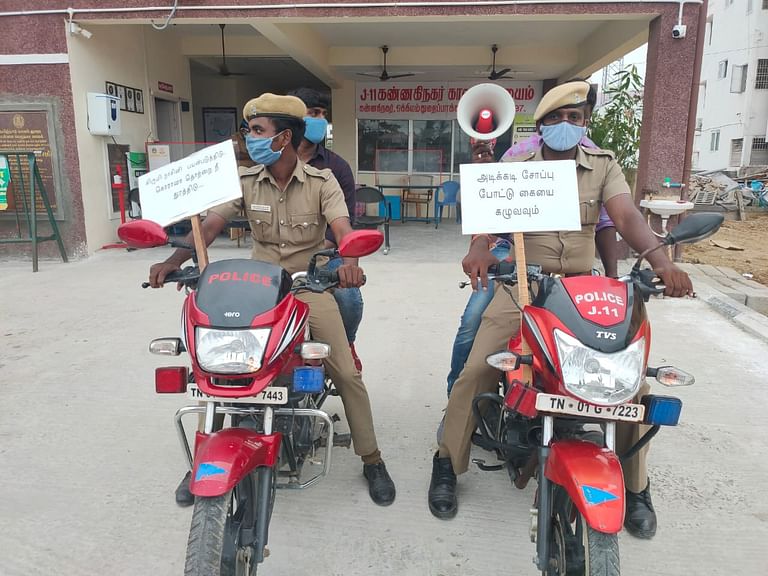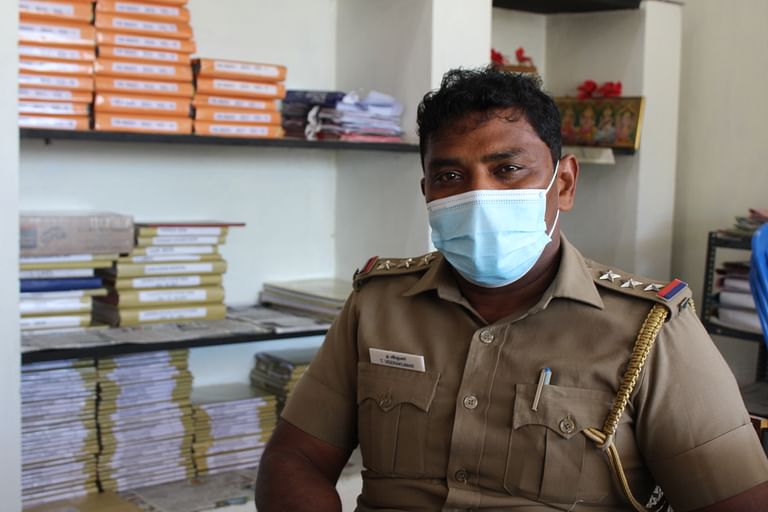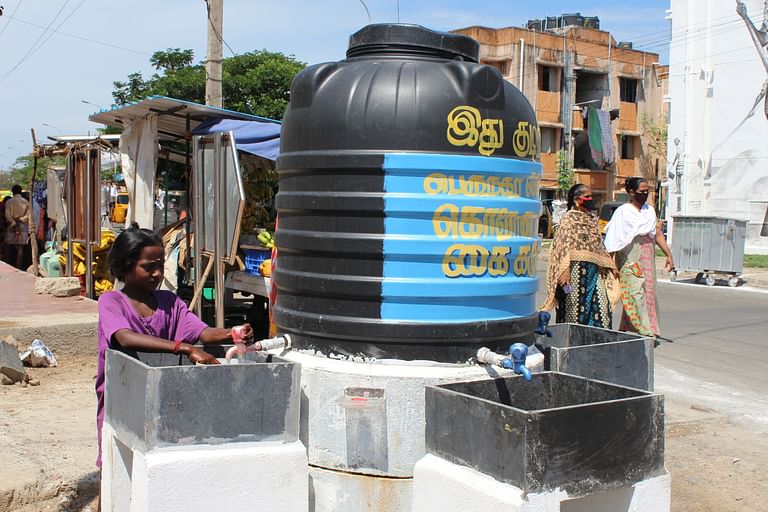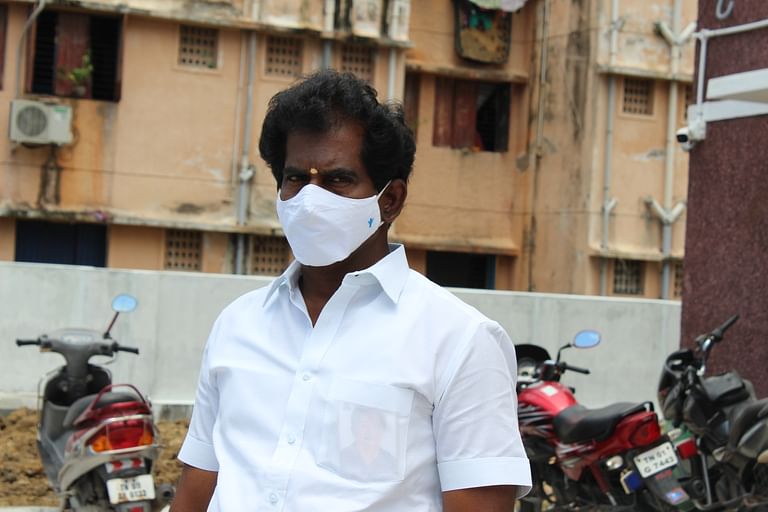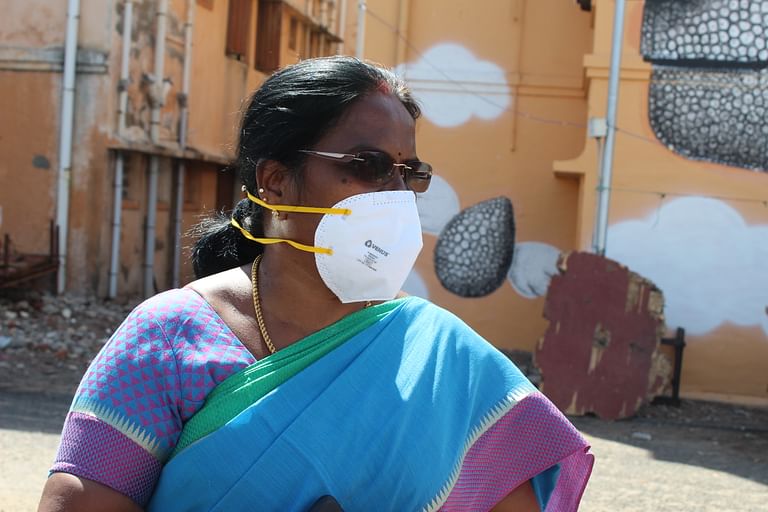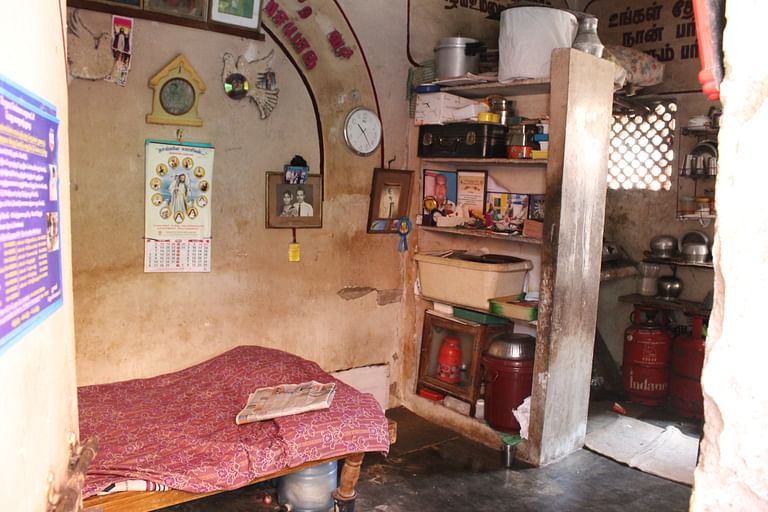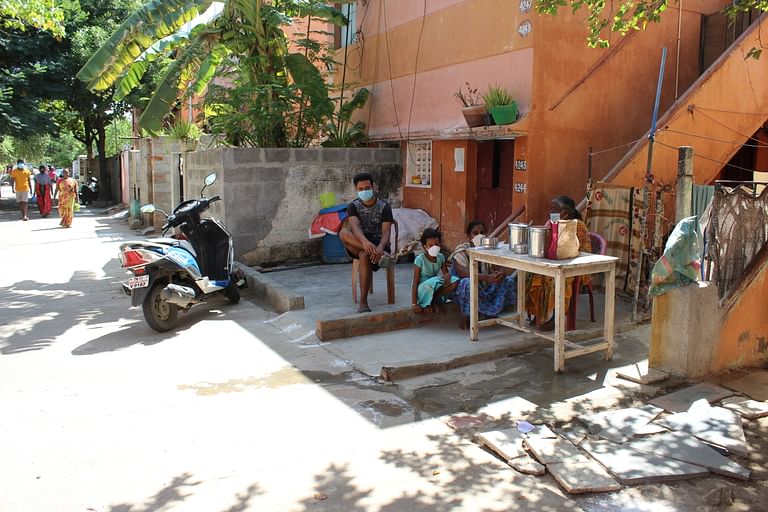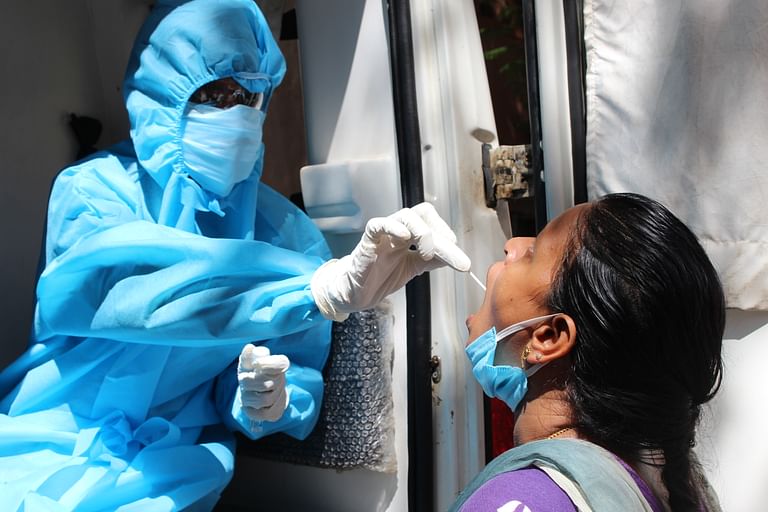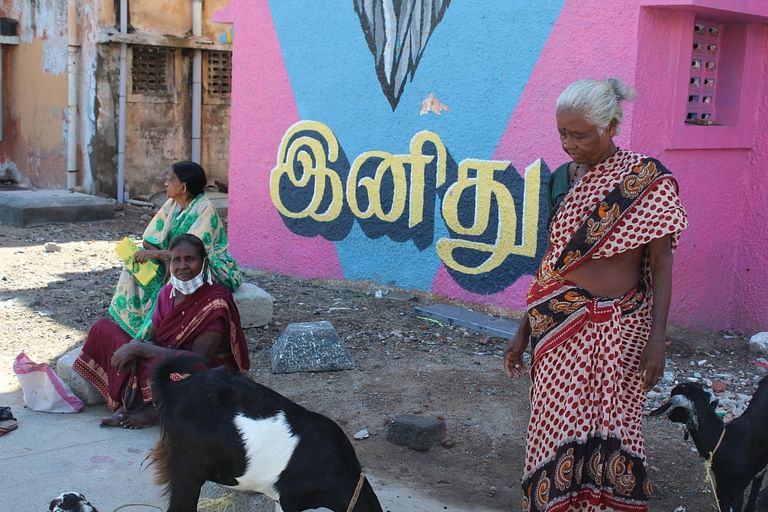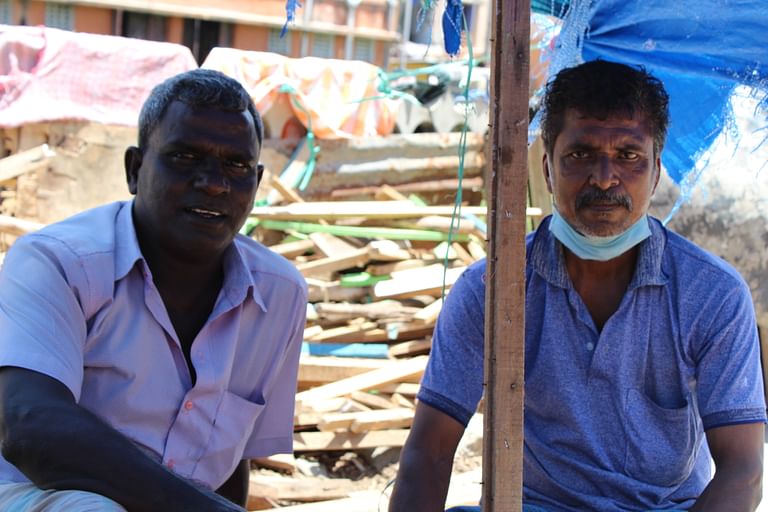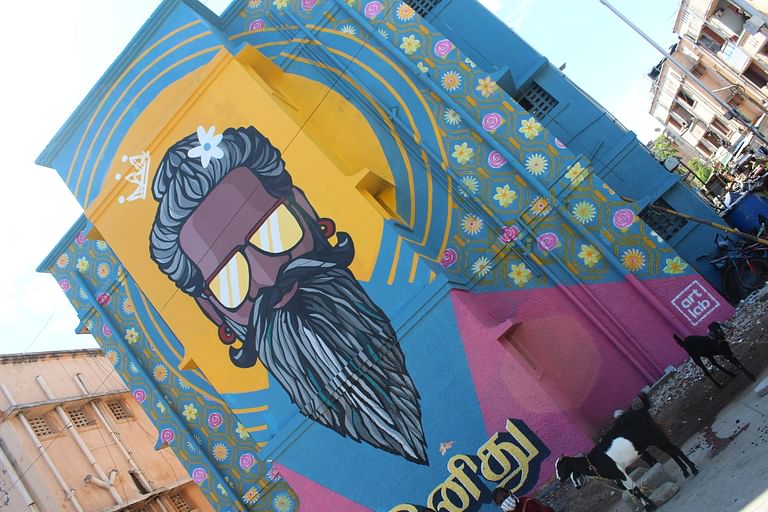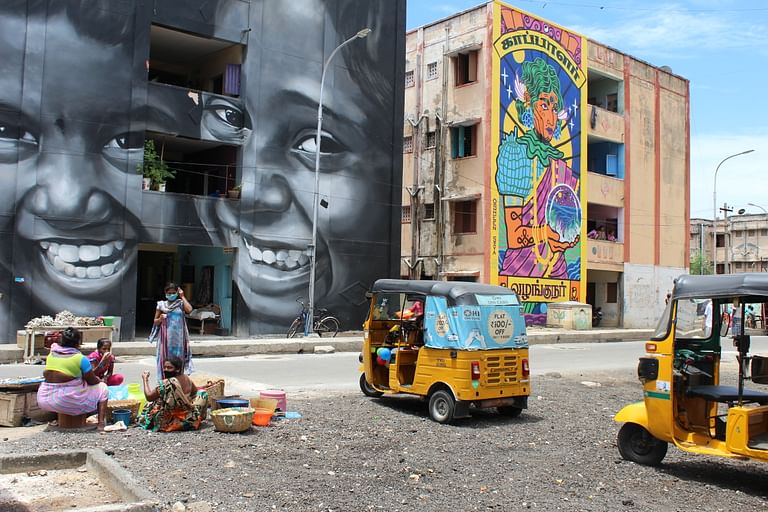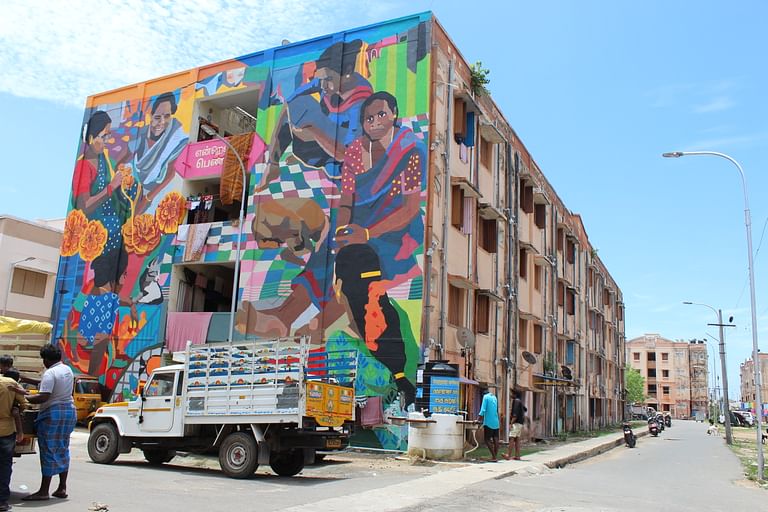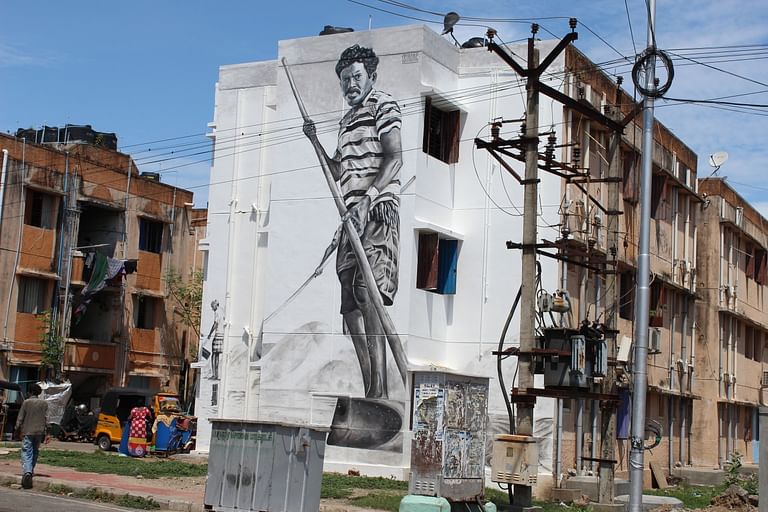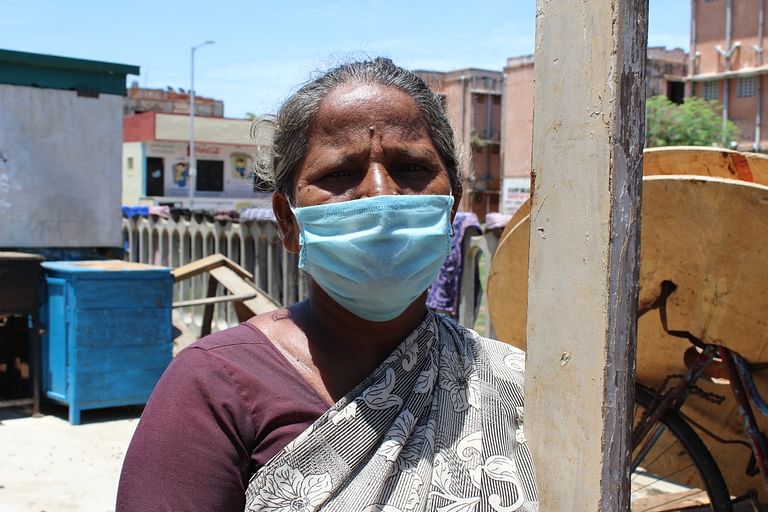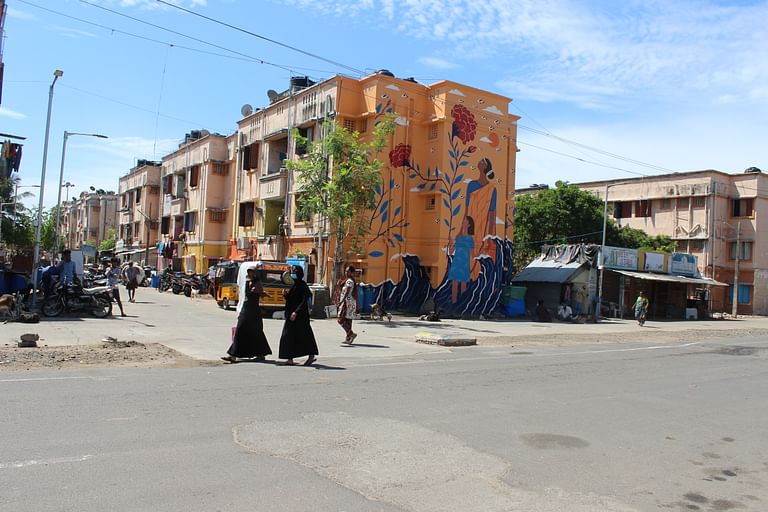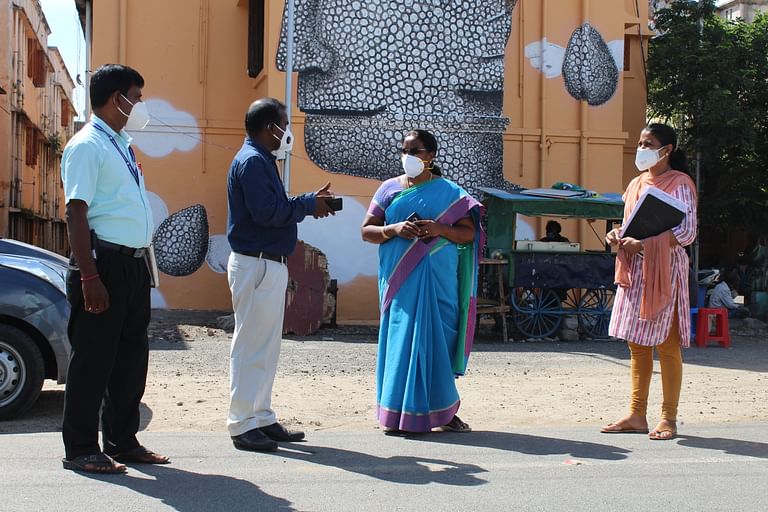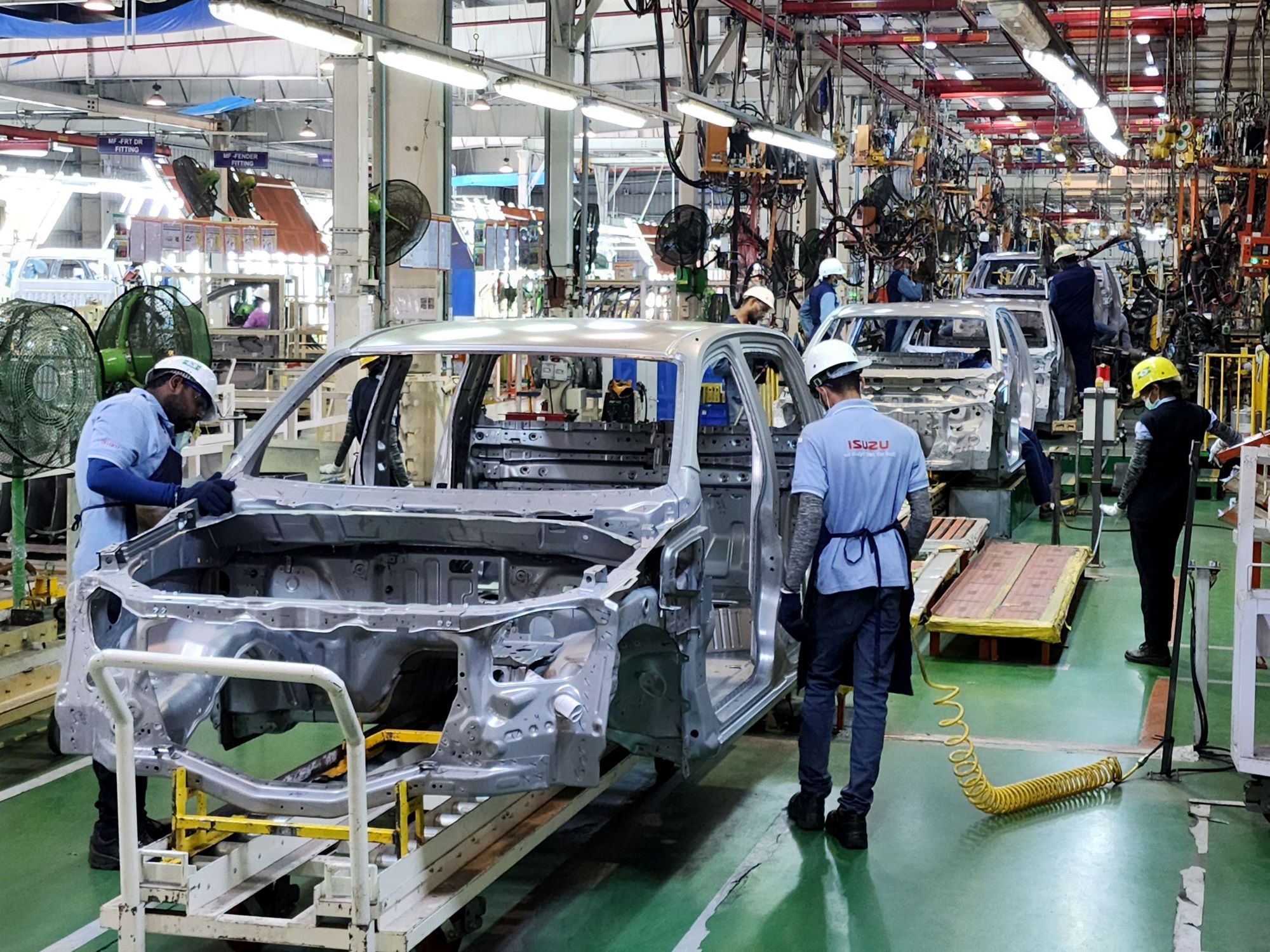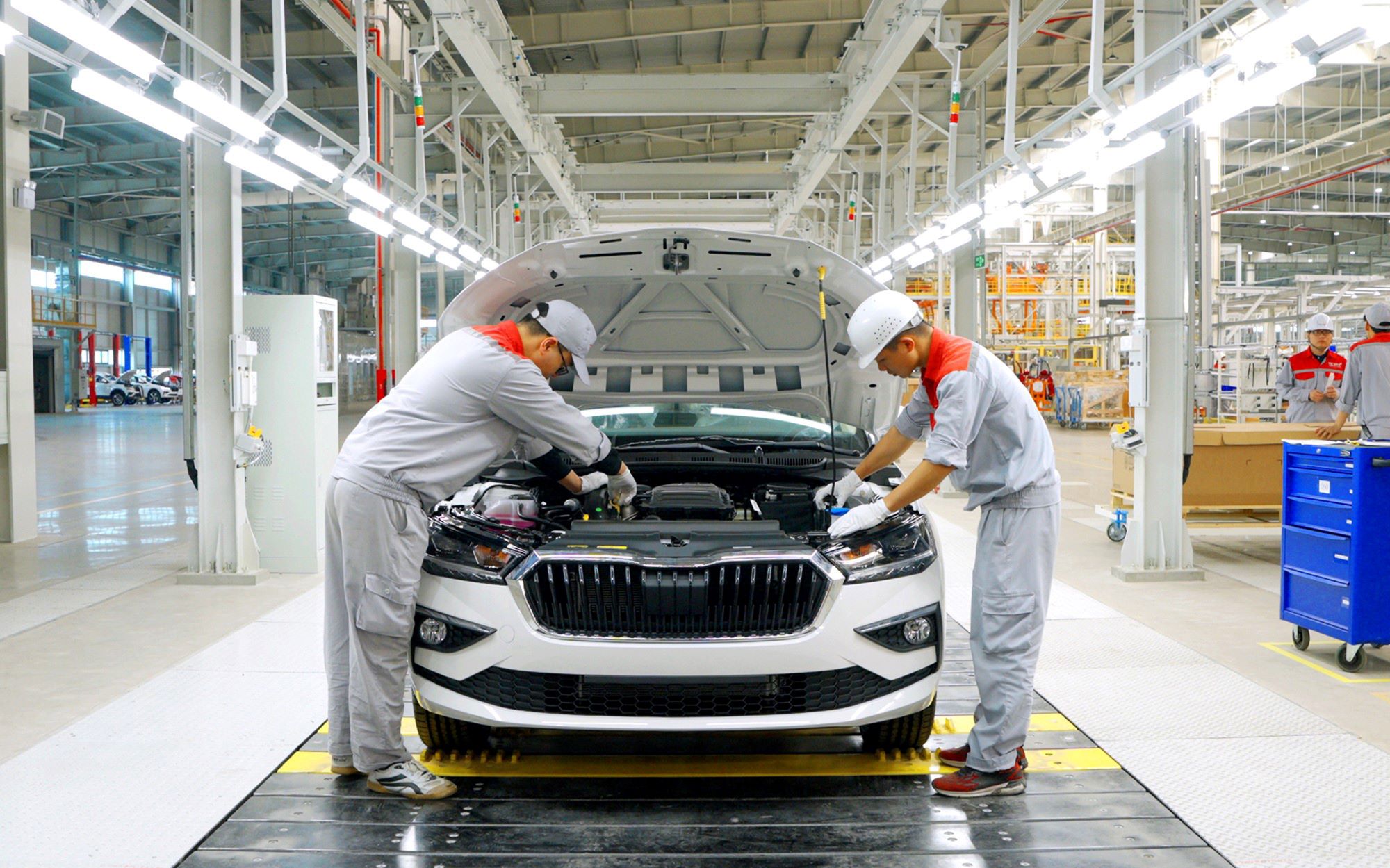Trending Now
- “I will soon make an announcement regarding a statewide tour across Tamil Nadu.” – O. Panneerselvam.
- Vatsala, Asia’s oldest elephant, has passed away at Panna Tiger Reserve; social activists mourn the death of this elephant, which lived for over 100 years.
- “The U.S. Govt earned ₹8 lakh crore this year through increased tariffs on foreign goods.” – U.S President Donald Trump.
- World No.1 Aryna Sabalenka has advanced to the semifinals in the Women’s Singles category at Wimbledon Tennis.
Tamilnadu News
How Kannagi Nagar Is Beating COVID-19, One Mask At A Time
![]() July 9, 2020
July 9, 2020
Kannagi Nagar is not bustling as usual.
There are a few stragglers on the roads of the slum resettlement project that came up in the wake of the Mass Rapid Transit System (MRTS) or the ‘Parakkum Rayil’ in 2000.
But 20-year-old B Yogeshwaran is a very busy young man. He wakes up early, has a quick bath and breakfast and heads out to the Panchayat Union Primary School in Kannagi Nagar.
Yogeshwaran is a “focus volunteer” Photo credit: Sandhya Ravishankar
He, along with 14 of his friends, “area boys” as they call themselves, stand six feet apart in rows to get their tasks for the day from the health officers and the civic authorities working in Kannagi Nagar.
Yogeshwaran is a “focus volunteer” and a third year B Com student at Jain College. Thanks to lockdown, his classes were suspended. So he decided to take up the volunteer job to fight COVID-19 in his area. Of course it helped that the Corporation of Chennai was paying Rs 15,000 a month to volunteers like him.
“First we have a morning gate meeting where we are told our duties, then we go see the old cases,” said Yogeshwaran.
“Each person has 15-20 old cases. We will deliver whatever their families need – milk, vegetables, medicines, water. After this we will go see the new cases, people who have just tested positive. We will stand by for any assistance as they are put into the ambulance and then the family is our responsibility,” he said.
Zonal Health Officer Dr D Gomathy addresses the gate meeting of “focus volunteers” Photo credit: Sandhya Ravishankar
Yogeshwaran then sets off, wearing a cloth mask to his “old cases”. When he gets there, he will change to an N-95 mask.
“If our duties are over early, we will call our friends and go to help them with their cases,” said Yogeshwaran.
Asked why he volunteered for such a tough job and whether he was not afraid of catching the virus, Yogeshwaran’s eyes crinkle in a smile masked by his mask. “This is social service as far as I am concerned,” he said. “We cannot think only of our own families, can we? If four other families are benefited by my work, it is a good thing, isn’t it?” he asks rhetorically.
People like Yogeshwaran and other “area boys”, along with health officers, Chennai Corporation staff, revenue department officials, NGOs, the police and politicians have all come together in Kannagi Nagar to defuse a potential ticking COVID-19 time bomb.
And the residents of Kannagi Nagar participated whole heartedly and ensuring high compliance with the rules of prevention.
Why Kannagi Nagar Is A Challenge
With 94,800 people living in 23,704 houses measuring 10 feet by 10 feet on average, Kannagi Nagar, in March and April, seemed ripe for a virus outbreak.
This is due to the fact that it is by far, the largest slum resettlement project in Chennai city.
After the MRTS project resettlement in 2000, tsunami affected fishing villages were resettled here in 2005 under the Emergency Tsunami Reconstruction Project.
Another 6000 houses have been added since, out of funds from the Jawaharlal Nehru National Urban Renewal Mission (JNNURM).
The tenements of Kannagi Nagar Photo credit: Sandhya Ravishankar
And authorities knew that it was only a matter of time before COVID-19 spread like wildfire among families living in such close proximity to one another.
But to everyone’s surprise, Kannagi Nagar has managed to prevent an outbreak and keep positive cases low at 508, of which 238 are active cases (as on July 09). There have been only seven deaths so far.
And a large part of this is due to the participation of the locals in keeping COVID-19 at bay.
Awareness & Masking
The first positive case was found in the second week of April. By May 08, there were 27 positive cases in Kannagi Nagar.
“By May 14 we had distributed two pairs of masks to every household in the tenement area along with a bottle of liquid soap with dispenser,” said Alby John, Regional Deputy Commissioner (South) under whose jurisdiction Kannagi Nagar falls.
To drive home the point about masking, authorities started with street vendors. “Street vendors, cart vendors, whoever was not wearing a mask, was initially warned and then we fined them too. Then we stopped them from vending – if you don’t wear a mask, you cannot vend. So it became clear to vendors that if they did not wear a mask, no economic activities could be carried out. This led to compliance at a very early stage itself and today you will see that no one goes out without wearing a mask,” said John.
Masking is par for the course in Kannagi Nagar Photo credit: Sandhya Ravishankar
Vehicles, both police, as well as autorickshaws hired by the Chennai Corporation, went around the lanes of the tenements, blaring messages about the importance of wearing masks.
Even today, loudspeakers tied to poles and trees, send out their monotonous recorded messages about compulsory masking.
With the second lockdown having been lifted on July 06, awareness about masking too has increased in Kannagi Nagar.
A Mask Force, comprising policemen on bikes and volunteers holding placards, move around the lanes of the tenements, reminding residents of why they need to mask up.
Masking force of the police Photo credit: Kannagi Nagar authorities
“We don’t fine them much, since most people living here are BPL (Below Poverty Line),” said T Veerakumar, Inspector of the Kannagi Nagar police station.
“We note down the names and addresses of those who don’t wear masks and we actually give them masks to wear. When the police jot down details, it scares people, so they wear it. It’s just a tactic. But don’t tell them that,” he grins.
Inspector Veerakumar of Kannagi Nagar Police Station Photo credit: Sandhya Ravishankar
Not just masking, hand washing too was enforced strictly. Volunteers were found – youngsters who are unable to attend college due to lockdown – and they were trained to help the authorities.
In each block, both sides were barricaded off and no resident could enter without washing their hands at a tap kept at each end of the two buildings.
Taps at street corners for hand washing Photo credit: Sandhya Ravishankar
“It is not easy to bring about behavioural change,” said Alby John, RDC (South). “But with the support of various stakeholders – police, NGOs, politicians and survey workers who go to each house and check on symptoms – the people took it up as a challenge and masking and hand washing became routine.”
Door To Door Surveillance
180 officials or enumerators were simultaneously deployed to conduct door to door surveys of symptoms on a daily basis. “So every time someone had a cold or a fever, it came to our notice immediately,” said Alby John, RDC (South).
Those who showed any symptoms were quickly brought to one of four medical camps set up in the bylanes of Kannagi Nagar. If the Primary Health Centre and Urban Community Health Centre were closer, they would be taken there for testing.
“We made it clear to all the workers that the fate of Kannagi Nagar is in their hands. This daily surveillance system was strengthened in early May. If there was a patient who went outside to a private hospital and got tested positive, we would question the responsible survey worker and ask why he was not able to pick up the symptoms and find out that the patient had those symptoms. This strengthened the surveillance in Kannagi Nagar,” said John.
Not only did surveillance find symptoms, it also helped create lists of vulnerable people who could be monitored closely. “We have identified painters in the area, who all have some respiratory trouble or the other,” said TC Karuna, the councillor of the area, a member of the ruling All India Anna Dravida Munnetra Kazhagam (AIADMK).
“We have a separate list for patients suffering from diabetes and hypertension. We have a tuberculosis list. All of these are people who are high risk and need to be checked upon regularly,” he said.
TC Karuna, AIADMK Councillor Photo credit: Sandhya Ravishankar
To stop outsiders from bringing COVID-19 into the area, police decided to close all roads leading to Kannagi Nagar except for one. The single point entry and exit is manned 24X7 and no outsider can slip in without the knowledge of the police personnel.
“Seven NGOs chipped in to help us with surveys and awareness programs,” said Dr D Gomathy, Zonal Health Officer. “The enumerators are Corporation staff while the “focus volunteers” and the “disinfectant force” are from the area,” she said.
Dr D Gomathy, Zonal Health Officer Photo credit: Sandhya Ravishankar
Like C Govindarajan, 40, who is a driver by profession. He owns a car and drives for “travels companies”. He was out of work, thanks to the lockdown. So he volunteered to be part of the 10-member “disinfectant force”.
“We ask them to eat first, then we ask them to come out,” explained Govindarajan. “Before they come out, we ask them to put a lid on all food and water. Especially kids and elderly people have to come outside. We spray their homes with Lysol and also the staircase handholds and the walls of the houses. We tell them to go inside only after half an hour,” he said.
Many blocks in Kannagi Nagar have shared toilets. These too are sprayed with disinfectant every day.
The “disinfectant force” is paid Rs 379 per day per person for their work.
A dedicated COVID helpline number for Kannagi Nagar and nearby Semmanchery too was started. So far it has received 1100 calls.
Dealing With Positive Cases & Contacts
The next big challenge was physical distancing and quarantining families of people who test positive.
Most apartments in Kannagi Nagar are like the one shown below.
An apartment in Kannagi Nagar Photo credit: Sandhya Ravishankar
Anywhere between three and five people live in such homes, making physical distancing a problem. This also meant that if one person in the family tested positive, the others would almost certainly catch the infection too.
Quarantining family members at home made little sense if the family was larger.
Initial experiments with home quarantining of the families and contacts of COVID positive patients did not work. Authorities had trouble keeping them at home and there was almost no way to find out whether they had stepped out.
Health officers then decided that entire families had to be moved out of their homes in order to prevent the spread of COVID.
Homes in Kannagi Nagar Photo credit: Sandhya Ravishankar
Authorities signed up around 15 “focus volunteers” from the local area, like Yogeshwaran, who are paid Rs 15,000 per month.
Their job was to ensure that if a block turned into a containment area, they would ensure that no residents went out.
They were also in charge of buying groceries or provisions for those in the containment zone. Additionally, these young men would participate in the mask awareness program.
“Relocation of the close contacts of positive patients has had a big effect on stopping spread,” said D Sukumar, Zonal Officer of Zone 15 which Kannagi Nagar comes under.
“We simply moved whole families to quarantine centres in Jain College and KCG College,” he said.
Getting positive patients into the ambulance in itself was an ordeal in several cases. “Some people would create a big fuss because they were afraid,” said Yogeshwaran, the “focus volunteer”. “Some would threaten to hang themselves if they were asked to get into the ambulance. We had to deal with them very softly,” he said.
Despite the difficulties, institutional quarantine of families did help stem the potential tide.
“The families also seemed happy,” said Alby John, RDC (South). “We gave them yoga training and the place was maintained well, thanks to NGOs and volunteers. By providing institutional quarantine facilities, we have managed to restrict COVID spread to a large extent,” he said.
Swabs being taken at a mobile testing centre Photo credit: Sandhya Ravishankar
If the contact of the positive person was a single family member, they were allowed to remain in home quarantine.
“We pasted my personal phone number on all doors and told the neighbours to call the number at any time of the day or night if the quarantined person stepped out,” said Inspector Veerakumar.
Almost as if on cue, the Inspector’s phone rang. “Yes, tell me ma… okay… what is the address? Block number 40 is it? What is the door number? 103? Okay, I will send someone,” he said and hung up.
“See I told you. This is a neighbour of someone who is supposed to be in home quarantine. The neighbour called to inform me that the person stepped out of the house,” he said, shouting out for his constables to hurry up and head to the address.
Conspiracy Theories Abound
While most of Kannagi Nagar appears to be happy complying with the rules, a number of residents are worried.
Kannamma, 56, frowns as she feeds her goats. “They are coming and taking people away and no one knows where they are being taken,” she told The Lede. “Especially elderly people like me. They take them away to hospital and they put oosi,” she said.
Oosi is injection in Tamil.
Kannamma (R) and Anjalai (maroon saree) are worried about the death oosi Photo credit: Sandhya Ravishankar
What oosi do they put?
“Death oosi, what else?” she snorts at the perceived stupidity of the question. “They want to kill all the elderly people.”
But why?
“I don’t know. You have to ask them why they are doing it,” said Kannamma.
Who told you this?
“Everyone says so. The people at the hospital told me. Sanitary workers who sweep the roads have told me. It is an open secret,” she claimed.
Her neighbour Anjalai, aged around 50, nods vehemently in agreement with Kannamma.
“This is not good, what is happening. They are saying Corona Corona but where is the Corona? There is no Corona,” she said firmly. “It is all a lie.”
Four streets away, K Ammuchi, 37, and R Sebastian, 56, an auto driver sit on the roadside with a bundle of old wood, hoping to sell it for a few bucks.
“There is no virus,” said Ammuchi firmly. “It is just normal phlegm, cough and cold. They are taking people away saying it is Corona and not allowing any of us to even see them. What are they doing with the people they take away? They must be taking away their kidneys and their eyes illegally,” she said.
Sebastian jumped in to reinforce her theory. “You don’t know ma. These things happen frequently. We all know that they are taking kidneys and eyes out of the people who are being taken away,” he stated.
Auto driver Sebastian (L) and painter-welder EN Ignatious (R) Photo credit: Sandhya Ravishankar
Luckily for the authorities, these conspiratorial voices are much fewer and softer than those of the majority of residents.
“In Kannagi Nagar what probably helped was that even before COVID, we were working in that area,” said Alby John, RDC (South). “We were doing an art district project – painting the buildings with murals – the first such project in the city. We interacted with a lot of local residents, a lot of youngsters. We know the people inside, we are not rank outsiders.”
Art district Photo credit: Sandhya Ravishankar
“All said and done, Kannagi Nagar is a planned layout. It is not a slum. It is a relocation project. The lanes are broad. The individual houses are thickly populated but manageable. In irregular slums, it would probably be much more difficult to control people from coming and going.
The whole effort got a lot of support from the public. It is not clear how it clicked but it clicked,” said John.
“I wouldn’t dare to say that it is a success story but we have had more success here than in other places,” he added.
K Praveen, 31, a painter and a member of the “disinfectant force” perhaps summed it up best.
“Idhu enga area” – this is our area. “We have to take care of our people,” he said.
Economic Distress Wave: Coming Soon
As Kannagi Nagar pulls through the worst of the COVID crisis, the next looming catastrophe is likely to be economic in nature.
A lower income population, most residents of Kannagi Nagar are employed as housekeeping staff in IT companies located on the Old Mahabalipuram Road or as security guards.
A large number of painters and house maids also live here.
Others are street vendors or own small roadside food stalls.
With the lockdown, almost everyone has lost their jobs.
Lavanya Arun, 30, has set up an umbrella and a plastic table with some home-made snacks to sell.
“I was working as a house maid in Sholinganallur,” said Lavanya. “I used to make Rs 1500 per month. My husband was working in a furniture shop in Ambattur as a salesman. Both of us lost our jobs. The family I worked for told me not to come since I was from Kannagi Nagar and they had read in the papers that the area was a red zone. There is no food in the house and I have two sons to feed. I have tried to set up this food stall here but I barely make Rs 50 a day,” she said.
Worse, Lavanya and her family moved from another part of Chennai to Kannagi Nagar to live in a rental house. So she has no ration card to get the free supplies of rice and pulses being provided by the state government. Nor has she got the Rs 2000 given by the state in two tranches.
Similar stories are told by M Tilaka, 29 and K Kasthuri, 50, both of whom run food stalls.
K Kasthuri runs a beef boti stall Photo credit: Sandhya Ravishankar
Kasthuri said she did not have the money needed to even make the beef boti that she usually sold. Tilaka too has run out of funds to make food to sell.
“What is the use? All of the people here are daily wage earners. No one has money to buy food from us even if we set up the stall,” said Tilaka.
EN Ignatious, 55, is in a similar situation. A painter and welder, he has only an Aadhar card and nothing else. “I have got nothing. No ration card, no income, no food, no money or rations from the government. Am I not counted as a life?” he asked.
A view of a block of apartments Photo credit: Sandhya Ravishankar
Authorities though say that the problem of people without ration cards in Kannagi Nagar was brought to their notice early on by politicians – both ruling and opposition party – in the area.
“Around 4000 people did not have ration cards,” said Alby John, RDC (South). “So we mobilised groceries and provisions and we gave it to these 4000 houses. This was during the initial part of the lockdown. The local influencers informed us that this was a big problem and it needed to be addressed. So we identified the houses without ration cards and handed over the supplies to them,” he said.
Health officers conversing at Kannagi Nagar Photo credit: Sandhya Ravishankar
But with no way of making a livelihood, no public transport and no money in hand, life has become tough for the people of Kannagi Nagar.
And this is perhaps a bigger challenge for the government to handle than the COVID crisis.





